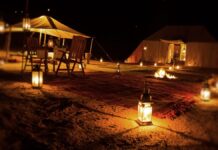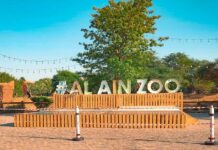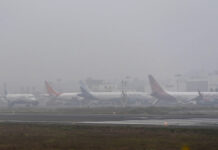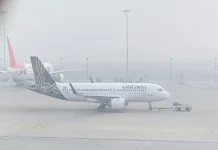Nubra Valley, in Ladakh, was once on the trading route that connected eastern Tibet with Turkistan via the famous Karakoram Pass. Nubra invites you to a trip back in time into a nearly forgotten ‘Shangri La’. With breathtaking views and delightfully hospitable inhabitants, it is quite an experience.
Best time to visit: Ladakh’s harsh winter makes this crossing possible only during the summer months-from June to August. The valley itself lies at a lower elevation than the Leh Valley, making it very fertile with cultivation of grains and fruits like peaches.
The valley lies 150 km from the city of Leh. Perched at a height of 10,000 feet above sea level, it is a popular tourist destination. Travelers are required to obtain an Inner Line Permit from Leh.
One passes through some of the most scenic locations in the region en route Nubra Valley. There are many small villages along the valley. These small settlements are known for their pristine beauty. Some of the villages are Sumur, Paramik and Tirith. The Paramik village is renowned for its hot natural springs. The people are predominantly Buddhist and there are many monasteries that can be seen along the Nubra Valley.
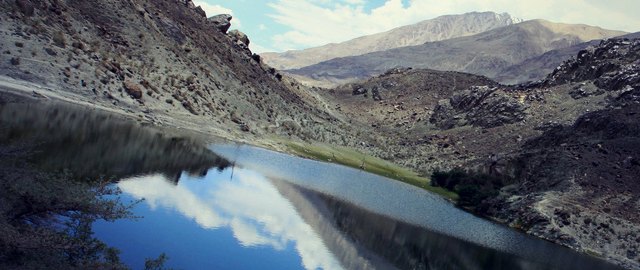
The Samstanling Monastery located near the Sumlur village and the Diksit Monastery in the Diksit village are the important monasteries located here. The village of Baighandu is renowned for its goats whose rich coat is used to produce the famous Pashmina Shawl. There are also many trekking spots near the Nubra Valley tourists can indulge on Kashmir holiday packages.
Diskit is the administrative center of the Nubra Valley. It nestles on the edge of a desert on the Shyok-side valley, eight hours away, on the other side of the Khardong La (La means Pass). To reach this place one should carry along plenty of water, because the increase in height by over 2000 meters, can give anybody severe headache and nausea. The road is paved till south Pulu, a military check post, where the permits are checked and the details entered. This is an unforgettable excursion that makes Indiana Jones look like a kindergarten excursion.
Surrounded by majestic Himalayas, it has the distinct smell of smoky kitchens, goats, chang (local brew) and butter tea and the fatal edge of the 100-meter sheer cliffs always closer than one really appreciates. One can spot various modes of transportation hundred meters below, at their final resting place.
Surrounded by the rising mountains of Himalayas and superb views down the Leh valley, the thrill is replaced by a feeling of utmost beauty. Snow lingers all year round on the mountains with prayer-flag topped peaks. A breathtaking experience indeed.
Descending into the valley, only the first few km are tricky. Soon, following a mellow stream, one would come into a surprisingly green landscape with rugged stone formations rising up into the sky with the peaks in the background. They look like they have been poured over with sugar. A real fairy tale landscape. As drastically as the landscape had changed from ‘moon-land’ on top of the Khardong La to a green oasis, one would enter a desert, easily comparable to the Thar in Rajasthan.
Diskit seems like a ghost town, an oasis of tranquility. An enjoyable day’s walk brings one to Somoor, half way to Panamik. Army trucks are the only means of transportation in the valley.
A Ladakhi meal is served sitting around the massive black stove in the kitchen, the most important room in any Ladakhi house. It is the place to warm up on a freezing winter night, the place where the family meets, the homework is done and the prayers are said.
Tiger is only another three km towards Panamik. It makes an easy afternoon stroll, inhaling the beauty and the calmness of the impressive, stimulating countryside. Coming across a local, one can be sure to be greeted with a warm smile and a joyful Julee.
The furthest place the permit allows one to visit in the valley is Panamik, the last settlement of any size before the Tibetan border. It’s not very wise to proceed further than the provided barrier at the northern edge of the town since this is a rather sensitive border area. It is completely controlled by the Indian Army, usually with very friendly soldiers.
The 250 years old Ensa Gompa, nestled on top of a rock overlooking snow-peaked mountains across the valley is much further away than it looks. It takes at least a six-hour walk to reach, which involves crossing the river at Hargam. The hot springs on the outskirts of Panamik invite one for a literally sizzling bath experience, which will most probably be the first contact with hot water since one leaves Leh.
The Nubra Valley is one of the last treasures of our planet, living in sheer isolation for most of the year in the heart of the great Himalayas. A real Shangri La, with no ‘Baywatch’, no mobile phones and no Ray Ban sunglasses.
Tourist attractions
Panamik: Perched at a height of 3183 m above sea level, the scenic village of Panamik in Nubra Valley is located around 140 km from Leh. It is situated at the Indian border before the Tibetan territory. The village is known for its curative hot water springs which are located on its outskirts. Panamik commands the stunning views of the surrounding snowcapped mountains.
Yarab Tso Lake: Yarab Tso Lake is considered to be holy and is also often referred to as hidden lake. It is situated near Sumur village, around 15 km from Diskit in Nubra Valley. It offers a magnificent serene surrounding that will truly capture heart and mind of any visitor. A 15-20 minutes hike uphill on a hillock will get you to the banks of this holy lake.
Diskit Monastery: One of the oldest & largest Buddhist monasteries in the Nubra Valley, the Diskit Monastery or Diskit Gompa was founded by Changzem Tserab Zangpo, a disciple of Tsong Khapa in the 14th century.
Festival of the Scapegoat – Dosmoche: One of the most popular prayer festivals in the Nubra Valley, the Dosmoche or Desmochhey – also known as the ‘Festival of the Scapegoat’ is celebrated at the Diksit Monastery. The same festival is also celebrated in Likir in Leh, but since it is celebrated in the peak winter of February when the Khardon peak is snowbound, all the locals gather at the Diksit Monastery to celebrate.
Hundur Monastery: Also known as Hundu Gompa, the Hundur Monastery is a Buddhist monastery located near the Diksit Monastery & Lachung temple. It is located near the bridge on the main road in the Nubra Valley.
Lachung Temple: One of the oldest temples in the region, Lachung temple has a statue of Tsong-kha-pa standing tall with a Gelugpa yellow hat crowns the image. It is located near the Diksit Monastery.
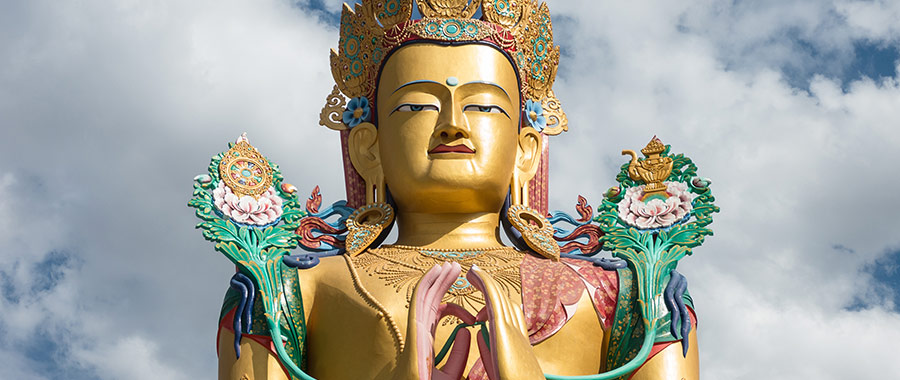 Maitreya Buddha: At the foothills of the Nubra Valley is the official residence of the Chief of Lamba of Nubra. Along with this stands the impressive 32 m Maitreya Buddha statue. Perched atop a hill, the statue faces the Shyok River towards Pakistan.
Maitreya Buddha: At the foothills of the Nubra Valley is the official residence of the Chief of Lamba of Nubra. Along with this stands the impressive 32 m Maitreya Buddha statue. Perched atop a hill, the statue faces the Shyok River towards Pakistan.
Samstanling Monastery: Founded by Lama Tsultim Nima around 140 years back, the Samstanling Monastery is located in the Sumlur village of the Nubra Valley region. Located 124 km north of the capital of Ladakh, Leh; around 50 monks reside in this monastery whose daily needs are taken care of by the monastery governing body.
Camel Safari in Hunder Sand Dunes: Sand dunes that lie between Hunder and Diskit in Nubra Valley lured many tourists, with camel safari being the main attraction. It is the place where one can enjoy Bactrian camel ride through the sand dunes. Unlike single-humped camels found in Rajasthan and other parts of India, Bactrian camels in Hunder have two humps and joyride on these camels would be a memorable experience in the Himalaya with a difference.
How to reach
There are regular buses run by the Jammu and Kashmir State Transport Corporation to cover the distance of 150 km from Leh to Diskit, the administrative headquarters. The roads are maintained by the army and sudden changes in weather are common. One should be prepared to face natural hazards when visiting Nubra Valley.
There is only one pass that vehicles can travel through. The travel time takes around 5 hours due to the difficult road and steep passes.
Only certain vehicles can pass through this road. SUV’s and four wheel vehicles are the best option to travel this road and it also requires experienced drivers. There are many streams that flow through the Khardung La pass.
Leh is the closest airport and has the closest railway station.




